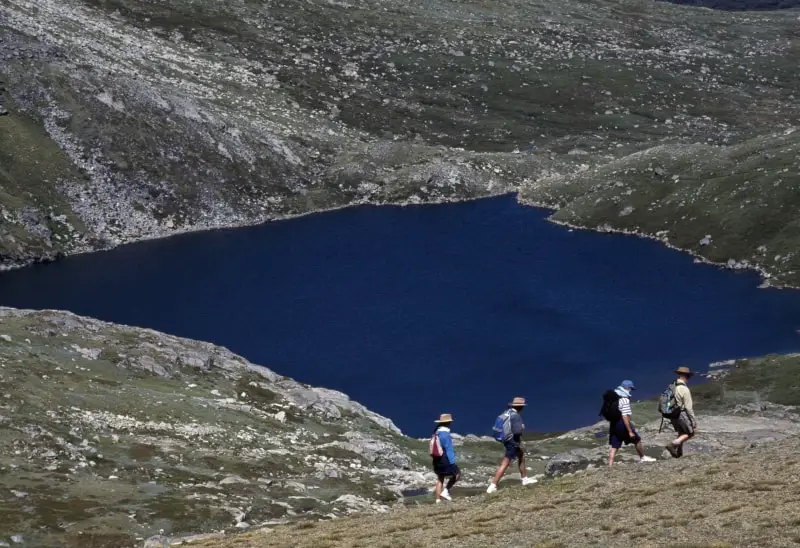More and more people are electing to use cremation when dealing with the death of a loved one. Cremation is not only more affordable, but it has become a streamline option with multiple options.
However, having received the “ashes” of a loved one, many people elect to set them free by scattering the ashes to the winds in a last act of farewell. In this article, I will look at some of the specifics of scattering ashes with a hope to help you make it memorable and to do it right.
To scatter ashes successfully, choose the perfect location that commemorates while considering if it’s public or private. Decide whether you wish to cast the ashes to the wind, bury the ashes in the earth, or do something creative with them. And put a little thought into the season that suits best.
Although it may seem like the most straightforward of tasks, scattering your loved one’s ashes is fraught with emotional and logistical headaches. Below I’ve gone through everything you need to know about completing this task with respect and poignancy

What are the laws in the US?
In the US, there are no all-encompassing laws regarding the scattering of ashes but there are certain things that need to be kept in mind. Furthermore, there isn’t any Department of Scattering Ashes Offenders in the local police force or even at the federal level.
So, there won’t be anyone chasing after you for scattering your ashes as you please. That being said, there are the moral laws of common courtesy and the civil section of private property.
However, this may not be the case if you are planning to do this in another country, so be sure to check with your local authorities for further information.
Another great option is to get the ashes made into a permanent piece of jewelry, you should check out the beautiful handcrafted pieces Mark Hamilton makes with cremains by visiting his site here.
Where can we scatter our ashes?

Next, we need to discuss some of the places that are commonly considered as ideal locations for the scattering of ashes.
Private or Public
The first consideration is to figure out if your desired location is private property or not. If it is, you need to ask permission to scatter or you can certainly find yourself with a civil suit brought against you, not to mention the charges of trespassing.
Here are a few places that are commonly thought of as being public, but which in fact might be private.
- The local sports stadium. Especially one with a professional team that sells tickets.
- A local park, wildlife sanctuary, or botanical gardens. Again, an admission fee is a good indicator that it might be private.
- An amusement park. Although they are usually subsidized by the government, they are most likely private.
- Historical site and museum grounds (I don’t think you are considering scattering the ashes inside the museum). Again these places are often privately run with the assistance of taxes.
- Beaches. Many beaches are purchased or leased by resorts and will fall into the areas of private property
I am sure there are more that we have overlooked but I think you get the point. The best policy is to ask staff members for more information.
National Parks
National parks don’t have the same consideration as the local park with swings and slides on the corner of your neighborhood block. Most national parks allow for the scattering of ashes with a few stipulations.
Again you have to talk to someone first; the head park ranger. It might be a simple courtesy but he will also be able to guide you as to a perfect location, and in some cases where required, help you to obtain the permit.
The ranger might supply you with directions to an awe-inspiring pristine spot while helping you avoid the high traffic, developed, and environmentally sensitive places that might cause you some unneeded grief (Speak to a professional today from the comfort of your home).
At Home
Another location that needs consideration is the shared garden in the backyard of your rented residence (if this applies to you).
Renting a property, or even owning a building on property owned by someone else, will fall under the umbrella of “ask before you scatter.” Some property owners might not look kindly on you scattering the remains of the dead on their land.
Now if you own the home, and the land. It is certainly a great choice. It is very unlikely that you will be subject to backlash on this, but you should discuss it with all your family.
For a more in depth look at the laws and practices of burying a loved one on your own property, check out my full article on this topic here.
Graveyards

Some graveyards are private property too and will follow the same considerations above. While others might be public. Find out which type you’re dealing with if this is the desired place you seek.
However, graveyards are, usually, meticulously maintained grounds and I don’t imagine that the groundskeeper wants you scattering ashes about. Sure, you can most certainly purchase a plot and bury your ashes there, but this is not what we are talking about here, is it?
All the land in a cemetery, especially one within city limits, is for sale or repurposed for aesthetic uses. Although this doesn’t signify “private property” necessarily, it does imply that it’s not free for anyone to use it.
Some cemeteries are accommodating in this manner and have actual “scattering gardens” purposed for this. If a graveyard is your desired place, perhaps these gardens might be the best place for you.
The Sea
Scattering one’s ashes to the sea is a nostalgic trope found from classic literature all the way up to modern media. The expired sailor is returned to the place of his love, the ocean. Or the land-locked man that never got the chance to see the sea is set free in the end to swim the waves for eternity.
Whatever your romantic reason, the sea is a wonderful place to scatter your loved one but again there are a few things to consider before you do it.
First, the Environmental Protection Agency says that it is safe and permitted. However, you must be “out at sea.” They state that a burial at sea must be more than 3 nautical miles out. The same principle should be applied to scattering ashes.
To help you visualize this roughly imagine you are standing on a beach looking out into the water. You see a boat traveling away from you. The point at which it disappears from your sight is about how far you’d need to be. Although it’s not impossible, it’s certainly not wading distance out in the waves.
You are going to need a boat.
If you are prone to getting seasick, the regulations do allow for this type of ocean burial to be performed from an airplane but the same distance also applies.
Also, if you are not considering actually “scattering” the ashes and hoping to drop the entire urn as a whole down into the deep blue there are regulations regarding this. Your urn must be fully biodegradable. Many crematoriums place ashes in urns inside plastic bags. Make sure yours isn’t or else you are going to need to do it yourself.
If you want to scatter your ashes alongside decorations, such as flowers (see my recommended florists). Again, here, the biodegradable rule applies. No plastic flowers.
If you need to order flowers for a funeral then I can really recommend BloomsToday.com as I had an excellent experience buying from their site. You can check out the deals they have here, but when I ordered it was 25% off! Fingers crossed!
The Wild
Although there isn’t much untamed land left in America. There are still some parts that are uninhabited. If your loved one was an outdoors lover. You might be looking to set them free one final time out into the wild.
Again, make sure it is not private property and practice the courtesy of avoiding locations of high traffic. But I’m sure if it’s the wild you seek, you’re not inclined to perform the scattering all along a well-worn hiking trail.
In the Wind
A common visualization is a mourner releasing the ashed of loved ones into the wind on the edge of some cliff. Again, this simply is covered with the considerations of if it is public or private and whether is it a location of high traffic.
I would think that a suitable mountain would be easy enough to find. But you can expect to find yourself needing a bit of travel outside the populated areas. Places your ashing in the wind will scatter them about much more and you will have to take much care that no other people are downwind from you.
Also, check the weather forecast to avoid gusting days as you do not want to be suddenly covered in the ashes you are scattering.
In the City
Perhaps your loved one loved the city. They loved the bustle of the rat race and thrived on the life of living among many. You might be trying to find a place that is suitable to place the ashes of your loved one among the many.
In the city, there are very few places, if any, that would make for suitable scattering locations. You certainly can’t scatter the ashes from the top of the Empire State Building. Also, Times Square is probably not a great idea either. As a rule, you want to avoid places that have high traffic, and in the city, there are very few places where there are no people, ever.
The only places I can think of, where people don’t walk in the city is on the waters of the rivers and ponds. Scattering ashes in inland waters is illegal in some states so you need to check with the authorities of the state you desire to scatter in.
What methods should you use?

Having discussed the suitable and less suitable locations of scattering ashes we now turn to the method of actually doing it. What are your options when it comes to how ashes can be “scattered”?
Now, the word scatter tends to imply the tossing of something, but here we will allow it to encompass any sort of placing or “setting it free.”
Some methods are more sensitive than others to the issues discussed above such as private property and being done among others.
Typically, there are two main methods of scattering ashes; casting and trenching. We will discuss each of these first then offer a few alternatives.
Casting Ashes
The typical method that comes to mind when we consider scattering ashes is the casting ashes method. This is the method of pouring the ashes out of the urn into the air and allowing them to fall where they may.
Ashes are extremely light as susceptible to “scattering.” They are easily blown about and you can expect them to not fall exactly where you intended. Be sure that there is nothing downwind, and if accuracy is of interest, reduced the height.
As mentioned above, common places to scatter ashes are; at sea, to the wind, and aerial scattering.
At sea, you will usually be casting from a boat. Again, check the wind direction to make sure the ashes land in the water and not on the deck of the boat.
To the wind, meaning up in the mountains, (or other high places), we need to take extra care of the direction of the wind and the multitude of places the ashes will actually land.
Aerial scattering is the final common method of casting ashes. There are many services already available for this. They will know the best way and be able to tell you the safest way to do this depending on the aircraft they use.
Trenching Ashes
Trenching is the method of burying ashes in the earth. Although this doesn’t explicitly imply scattering it is certainly a common way to set your ashes free.
Perhaps, you went with cremation, with whatever reasoning you had, but want to continue the tradition of being buried with your family.
Alternatively, perhaps someone wants their loved one to be returned to the earth directly instead of spread over it. They might seek out a memorable spot from the life of the passed and choose this for the burial of ashes. Or perhaps, several locations might be chosen as each meant something to the deceased, so scattering is unsuitable.
Here are 3 types of burials; simple burials, dig a hole and insert the ashes only; green burials (for more information see my article on this topic here), choose a biodegradable urn and bury that along with the ashes; and tree urns, mix the ashes among potting soil to which you plant a tree or plant of choice.
There might also be some more specific type of burial that speaks specifically of the memory of the deceased.
Alternative Methods

Casting and trenching might be the most common but they certainly are not exhaustive options. Here are a few other options that come to mind.
Ringing Ashes
In ringing ashes, the ashes are passed around a group of mourners and they all take turns scattering or trenching the ashes. Granting each member of the circle their own personal moment of farewell.
Diamonizing
In recent years, the technology of converting ashes (cremation remains) into diamonds has developed rapidly. It’s not a valid option for many people and is often purposed for jewelry.
The process is rather complex and is worthy of an article of its own, so we won’t go into it here. Furthermore, owing to the rarity of diamonds being scattered, I also feel that it might belong elsewhere.
Artistic Repurposing
Adam Brown of Missouri offers a particular service. He uses the cremation remains to produce portraits of the deceased. Although he mostly does portraits, I am sure he would be more than willing to depict a natural scene to produce a metamorphic setting free.
Perhaps he might even paint the mourner scattering ashes to the wind on the edge of a cliff in a mythical mountain range. Of course using real ashes to paint the ashes in the painting.
Space
With the Virgin Galactic announcement that they plan to allow for commercial passenger trips to space, an extraterrestrial casting might be in the future, if not in the near future.
Since you will have to wait for this, we can look at options that are currently available. Elysium Space, a startup from San Francisco, has scheduled launch options for people looking to send ashes to space. People sign up to have their loved ones’ ashes sent into sun-synchronous orbit for about $2,500.
What time of year is best to do it?

Finally, a few words as timing. Seasons can permit and limit the methods of scattering you choose. Nonetheless, you don’t have a major timing issue. The ashes will keep and you can certainly wait for the season of your choice to arrive.
Winter is most likely the most limiting. Frozen ground is hard to dig in. Frozen water is hard to scatter into. The temperature in winter can also make boat and plane rides unpleasant.
That being said, winter does not make it impossible. If your loved one loved to ice fish, being scattered into a hole might suit them well. You might be able to find a location where you can ski down a mountain scatter the ashes in your wake.
Spring is the season of new beginnings and might be an ideal time for saying final goodbyes and moving on in life. It is also an ideal time for tree urns to be planted. The flowers are blooming, wildlife is awakened and can be a very pleasant time of year. But be wary of the rain.
Summer is also a beautiful season, vibrant with life and growth. The weather is usually agreeable, if not too hot. And it can certainly be a great time to scatter.
Fall is the season of sleep. Its natural gloom can offer a tailor-made atmosphere for mourning. There most likely won’t be much unfavorable weather either.
What should we say while we scatter?
This is a difficult answer to give. I don’t see any reason why you would say anything different than when you are performing a standard burial.
That being said, you might want to temper your words with the theme of setting free and it suits much more here than in the traditional burials.
Alternatively, you can remain silent and allow your thoughts to turn to the memory of your loved one knowing now physically and symbolically they are at peace.





